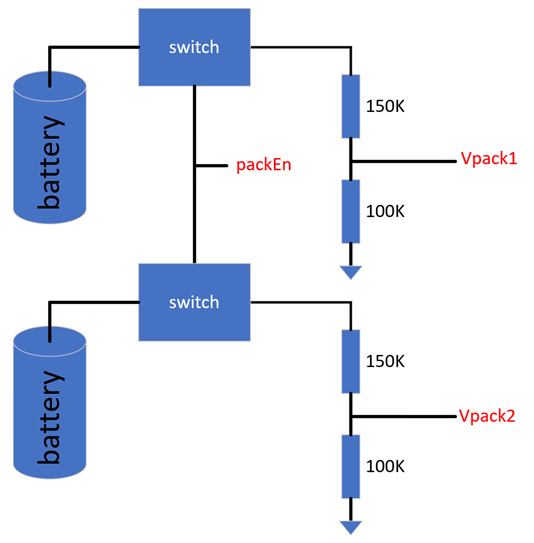Hi all,
I'm quite new in Zephyr. Just to let you know ;P
I'm developing a code based on the nRF52832 in a custom board and I'd like to measure the voltage of two separate batteries.
These batteries are connected to a resistor voltage divider which is enabled or disabled by a digital switch. Here is the schema

* packEn: 1 --> enables the two voltage dividers, 0--> disables the connection to the batteries
* Vpack1 --> Connected to AIN4
* Vpack2 --> Connected to AIN5
I'm using the nRF Connect SDK v2.4.1 with VS code.
In the main loop I read periodically the Vpack1 and Vpack2, but the values I get are random in most of the cases.
I'm sure that it's a configuration issue in the ADC, but I cannot find it, so I hope you can give a hand to find out what's the problem. Thank you.
This is my code:
#define HW_MAP_BAT_ENABLE_PIN NRF_GPIO_PIN_MAP(0, 30)
#define HW_MAP_BAT_R1_DIVIDER_VALUE 150000.0f // Value in ohm
#define HW_MAP_BAT_R2_DIVIDER_VALUE 100000.0f // Value in ohm
#define DRV_BAT_PACKS 2
typedef struct
{
bool valid;
struct
{
bool present;
int16_t voltage;
}pack[DRV_BAT_PACKS];
}drvBat_st;
static const struct device *adcDev = DEVICE_DT_GET(DT_NODELABEL(adc));
#define DRV_BAT_ADC_RESOLUTION 12
#define DRV_BAT_ADC_GAIN ADC_GAIN_1_3
#define DRV_BAT_ADC_REFERENCE ADC_REF_INTERNAL
#define DRV_BAT_ADC_ADQUISITION_TIME ADC_ACQ_TIME(ADC_ACQ_TIME_MICROSECONDS, 40)
#define DRV_BAT_ADC_PRIMARY_CHANNEL_ID 4
#define DRV_BAT_ADC_PRIMRAY_CHANNEL_INPUT NRF_SAADC_INPUT_AIN4
#define DRV_BAT_ADC_SECONDARY_CHANNEL_ID 5
#define DRV_BAT_ADC_SECONDARY_CHANNEL_INPUT NRF_SAADC_INPUT_AIN5
static const struct adc_channel_cfg primary = {
.gain = DRV_BAT_ADC_GAIN,
.reference = DRV_BAT_ADC_REFERENCE,
.acquisition_time = DRV_BAT_ADC_ADQUISITION_TIME,
.channel_id = DRV_BAT_ADC_PRIMARY_CHANNEL_ID,
.differential = 0,
#if defined(CONFIG_ADC_CONFIGURABLE_INPUTS)
.input_positive = DRV_BAT_ADC_PRIMRAY_CHANNEL_INPUT,
#endif
};
static const struct adc_channel_cfg secondary = {
.gain = DRV_BAT_ADC_GAIN,
.reference = DRV_BAT_ADC_REFERENCE,
.acquisition_time = DRV_BAT_ADC_ADQUISITION_TIME,
.channel_id = DRV_BAT_ADC_SECONDARY_CHANNEL_ID,
.differential = 0,
#if defined(CONFIG_ADC_CONFIGURABLE_INPUTS)
.input_positive = DRV_BAT_ADC_SECONDARY_CHANNEL_INPUT,
#endif
};
static drvBat_st bat;
rc_t drvBat_Init (void)
{
//
// Init the ADC channel configuration needed
//
static bool init = false;
if ( true == init )
{
return RC_SUCCESS;
}
// Configure adc channels used to measure battery voltage
if ( 0 != adc_channel_setup(adcDev, &primary) )
{
return RC_ERROR;
}
if ( 0 != adc_channel_setup(adcDev, &secondary) )
{
return RC_ERROR;
}
// Init battery power control
nrfx_gpiote_out_config_t config = NRFX_GPIOTE_CONFIG_OUT_SIMPLE(false);
nrfx_gpiote_out_init (HW_MAP_BAT_ENABLE_PIN, &config); // Configure battery control pin
init = true;
return RC_SUCCESS;
}
rc_t drvBat_Measure (void)
{
//
//
//
int16_t samples[2];
const struct adc_sequence sequence = {
.channels = BIT(DRV_BAT_ADC_PRIMARY_CHANNEL_ID) | BIT(DRV_BAT_ADC_SECONDARY_CHANNEL_ID) ,
.buffer = samples,
.buffer_size = sizeof(samples),
.resolution = DRV_BAT_ADC_RESOLUTION,
.oversampling = 0, // don't oversample
.calibrate = false // calibrate
};
nrfx_gpiote_out_set(HW_MAP_BAT_ENABLE_PIN); // Enable the voltage divider
k_msleep(DRV_BAT_ENABLE_TIMEOUT); // Little wait to ensure that voltage is stable before performing an adc read
if ( 0 != adc_read(adcDev, &sequence) )
{
return RC_ERROR;
}
nrfx_gpiote_out_clear(HW_MAP_BAT_ENABLE_PIN); // Disable the voltage divider
for (uint8_t i=0; i<DRV_BAT_PACKS; i++)
{
int32_t raw = (int32_t)samples[i];
if ( 0 != adc_raw_to_millivolts(DRV_BAT_ADC_REFERENCE, DRV_BAT_ADC_GAIN, DRV_BAT_ADC_RESOLUTION, &raw) )
{
return RC_ERROR;
}
bat.pack[i].present = false;
bat.pack[i].voltage = (int16_t)(raw / DRV_BAT_DIVIDER_FACTOR);
if ( 0 > bat.pack[i].voltage )
{
bat.pack[i].voltage = 0;
}
if ( DRV_BAT_MIN_VOLTAGE <= bat.pack[i].voltage )
{
bat.pack[i].present = true;
}
}
return RC_SUCCESS;
}
Thank you so much for your help
Ragards,
David


